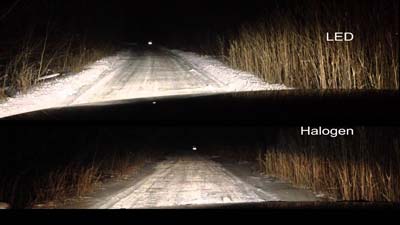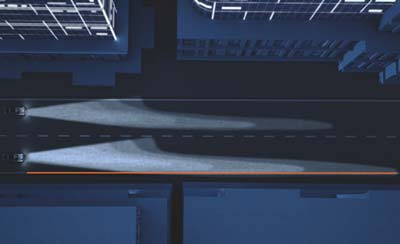Nowadays, 90% of all cars use halogen headlights. They are the most common and cheapest these days. But they come with a few disadvantages that its alternatives do not.
Among the alternatives, we’ll find LED headlights. These are newer types of headlights that emit more brightness and produce less heat by using less power. But of course, they also have their own set of drawbacks.
Here, we’ll go deeper into halogen vs LED headlights so you can have a better idea of what they offer and how you can pick the right one.
If you’re interested in what they have to offer or you’re just a curious mind looking to know more about each, this article is for you.
Table of Contents
LED vs Halogen: Power

The first thing you’ll notice when comparing LEDs with Halogen bulbs is that they use power way differently.
LED
A LED light uses less voltage than halogen. This happens thanks to a quicker and more efficient communication system between the electronics of the bulb.
Usually, an LED bulb uses between 30 and 35 watts to deliver proper brightness. But they need a few additional electronics like a fan and temperature system to make sure that they don’t overheat.
Halogen
A halogen bulb is a more standard option. It won’t use energy too efficiently with its simple construction and lack of electronics. This means that halogen lights will use between 50 and 60 watts.
Power Verdict
As you can see, a halogen uses way more power than an LED headlight. But this translates into a less bulky construction. But overall, LED uses less power, so it can be your best bet if you want to save some energy.
LED vs. Halogen: Efficiency

Following the power needs of each headlight, we now go to the efficiency sector. Here, you will have to look for the best luminous efficiency possible.
LED
Most LED lights are white. This means they use energy much more efficiently by emitting a less intense brightness. Following this, most LEDs have a luminous efficiency of about 20%.
In the most efficient models, you can achieve up to 50% of headlight efficiency. In short, they use less power to produce more light.
Halogen
In contrast with LEDs, Halogen bulbs emit as much light as they draw in power. They are not even half as efficient as an LED bulb.
The luminous efficiency of a halogen headlight is about 4%. In the best-case scenario, you can get up to 8% of luminous efficiency.
So, they use a lot of power to produce a decent amount of light.
Efficiency Verdict
In power and luminous efficiency, LEDs are also winners by almost twice the performance. This happens because LED bulbs produce light by transferring current through a conductor that produces protons and then the light.
Halogen bulbs, instead, need to produce heat in their filament until it gets hot enough to light up. So, they draw more power to keep their filament hot.
LED vs. Halogen: Response Time

After learning a little about efficiency and how headlights produce lights, it is time to go over the response time. This will let you know how fast the headlights react depending on what you pick.
LED
Using the semi-conductor that receives the current and produces photons of light, they light up almost instantly. The whole process is continuous and demands little to no power to work, as said before. This ensures that even with low energy, an LED light can turn on without problems.
Usually, they take about 0.1 seconds to light up. This is how fast an LED headlight works once it receives current.
Halogen
A halogen headlight uses a tungsten filament that heats up with current until it lights up. It needs a lot of constant electricity to work well. This means that most halogen bulbs light up a little slow compared to LED lights. Typically, a halogen headlight turns on in 1.2 seconds after it receives current.
As you know already, this happens because it needs to heat up the filament, and that could take a second.
Response-Time Verdict
The response time of an LED is way better than the response time of a Halogen headlight. You probably won’t feel the difference, but it also changes how well the headlights react if there are power issues.
By using less power and lighting up faster, LEDs are often much better when it comes to responsiveness.
LED vs. Halogen: Brightness

Brightness in headlights is measured in lumens. The more lumens a light has, the more intensity it will offer.
LED
Even though an LED headlight uses only 35 watts of power in its maximum power requirement, it produces an outstanding amount of 3000 lumens. So you can have an idea: 3000 lumens is about two or three regular flashlights paired together.
Halogen
On the other hand, you have the halogen using about 55 watts of power. This will be enough to produce 1200 lumens. Due to the inefficient lighting-up process, they are less bright than LEDs. But that’s because they have fewer electronics and parts, so they work deficiently.
Brightness Verdict
When it comes to brightness, LED bulbs are up to 5 times better than halogen ones if you consider the amount of energy it needs to produce the same amount of light. But of course, a halogen headlight does not typically surpass the 1200 lumens.
In contrast, an LED light can go over 3000 lumens without problems. So, yes, LED headlights are way better when it comes to brightness.
Halogen vs LED: Colors

Some headlights offer the chance to produce different colors. This is not necessarily something useful to consider, but it can make a difference depending on what you’re looking for.
LED
Most LEDs offer a white light. But due to the different components and lighting process, they offer the chance to alter the color depending on your needs. Of course, it is only possible to change the color in the manufacturing process. But some LEDs can still offer different colors depending on their build.
Halogen
Halogens work using a filament and not many other components. This reduces the chance to change the color, even in the manufacturing process. However, some halogen bulbs can be changed from white to yellow light. But the process is uncommon, so you’ll rarely find colored halogen headlights.
Colors Verdict
When it comes to colors, only LED bulbs offer the versatility to go from one to another depending on their build.
Halogen models may also come with this feature, but the color availability is limited. And this is unlikely to happen, so you’ll hardly find them this way. Overall, LED lights offer better color selection if you want to change the tone of your car’s headlights.
LED vs. Halogen: Light Distance

The distance refers to how far the light the headlight produces can travel. Of course, you’ll want something that goes as far as possible for the best experience.
LED
An LED bulb can provide 3000 lumens, which are enough to go up to 300 meters. This can light up an entire football field up to three times.
Halogen
A halogen bulb, on the other hand, only produces 1200 lumens at maximum. This can provide enough light to reach 100 meters of distance.
Light Distance Verdict
When it comes to distance, an LED headlight will win the game. Being brighter makes their light reach much farther.
LED vs. Halogen: Size
This is an often-overlooked factor when it comes to headlights, but it can actually make a difference depending on the type of car you’re using. The larger the headlight, the more difficult it will be to install.
LED
When we talk about LED headlights, we’re talking about an entire lighting system that comes with a bulb, a cooling system, and often a thicker glass. This makes LED lights really large and sizable.
Halogen
In contrast, a halogen headlight does not have too much bulkiness. It is a straight bulb with a filament that heats up. Without a cooling system or any other parts to consider, they’re relatively small.
Size Verdict
Here, halogen bulbs are way better if you ever need a small option. But smaller doesn’t necessarily mean better; it will just fit in most places compared to LED bulbs.
This is why some people eventually have problems setting up their car’s headlight for LEDs when there were halogen bulbs before. They are larger, so they are more challenging to install in halogen-oriented systems.
LED vs. Halogen: Lifespan
The overall durability of the headlight is another major factor to think about. And the lifespan of a headlight is often measured in hours of use. You’ll want your light to last as many hours of use as possible, so you won’t have to change it too often.
LED
When it comes to LED headlights, you will see that most manufacturers say that they can stand up to 50,000 hours of use. That wouldn’t be too far from reality. But the average lifespan of an LED is between 20,000 and 30,000 hours.
Halogen
As for halogen bulbs, you are more likely to find a lifespan of about 500 hours up to 1000 hours in the best-case scenario. This is way less than any LED can offer, which is a considerable disadvantage.
Lifespan Verdict
As you can see, LED headlights are much more durable than halogen ones. This happens because the lighting process of LEDs uses a much more efficient system that reduces heat and prevents internal damage.
In contrast, halogen bulbs heat up the tungsten filament, which loses strength over time, reducing its lifespan every time you turn it on.
LED vs. Halogen: Cost
Now it is time to learn more about the prices of both LED bulbs and halogen headlights. Here, it is essential to consider all the previous factors so you can have a better idea of what you’re getting for the cost.
LED
By now, you are already familiar with all the different advantages LED headlights have to offer over halogen ones. But all those benefits come at a price.
Being a relatively new technology, offering way better efficiency, providing more brightness, and being more durable makes them increasingly more expensive than halogen headlights.
Replacing a LED headlight can be slightly harsh for your wallet. Even though they are long-lasting, you may still need to replace them from time to time – and that can be costly.
Despite their price, LEDs are still worth having. They’re just better in almost every way.
Halogen
What halogen stands for is affordability. Yes, they are way less efficient and bright than most LEDs, but they are way cheaper as well. Even though they perform poorly compared to LED lights, they offer decent performance without having to spend a third of the price of what LEDs cost.
You can actually replace halogen bulbs without having to think twice. Sometimes, they come so cheaply that you may even end up with entire replacement sets at home just in case.
Cost Verdict
Here, you could say that everything LEDs are better for is a significant elevation on the price. Being wildly better than most halogen bulbs, LED lights are often 3 to 4 times more expensive.
If you are short on budget and/or don’t care much about performance, then go for a halogen headlight. But if you care about the overall capacity of the headlight and its durability, then spend a few more bucks and get an LED model.
Conclusion
In the end, LED bulbs are the better option in almost every way. Despite their high price, they are becoming more and more popular, and their technology is improving over time, Which is better than halogen or led, which decreases their price slowly.
Still, it will be a long time until they become as affordable as halogen headlights, but they’re on track for that. In the meantime, getting a halogen model will be a perfect way to save some bucks and get decent headlight performance.
But if you really care about quality, then an LED headlight is the way to go.
